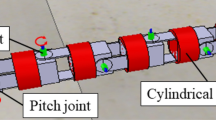Abstract
Snake robots could be utilized in many fields because of their hyper-redundant properties, although there are still control problems when they are operated in complex environments. For example, a helical rolling motion has been used to climb a pipe. By using this kind of motion, a snake robot can move along the inside or outside of a pipe. However, this motion has limitations when the robot moves along a pipe containing a high gap or a branch point. In this study, we propose a type of motion for snake robots that involves wrapping around the outside of a pipe to overcome a branch point on it. This new motion uses a hyperbolic function to make a helical wave curve, which is then propagated by shifting the shape of the hyperbolic function along the body of the snake robot. The joint angles of the snake robot are derived by calculating the curvature and torsion of the curve on the basis of the formula of the continuous curve model. Finally, the results of simulations performed using the Robot Operating System and Gazebo programs are shown to validate the effectiveness of the new motion.

















Similar content being viewed by others
References
Hirose S (1993) Biologically inspired robots (Snake-like Locomotor and Manipulator). Oxford University Press, Oxford
Mori M, Hirose S (2001) Development of active cord mechanism ACM-R3 with Agile 3D mobility. IEEE RSJ Int Conf Intell Robots Syst 3:1552–1557
Kamegawa T, Matsuno F, Chatterjee R (2002) Proposition of Twisting Mode of Locomotion and GA based Motion Planning for Transition of Locomotion Modes of 3-Dimensional Snake-like Robot. IEEE Int Conf Robot Autom 2:1507–1512
Date H, Takita Y (2005) Control of 3D snake-like locomotive mechanism based on continuum modeling. In: Proceedings of IDETC/CIE ASME international design engineering technical conferences and computers and information in engineering conference, pp 1351–1359
Rollinson D, Choset H (2013) Gait-based compliant control for snake robots. In: Proceedings of the IEEE international conference on robotics and automation, pp 5123–5128
Kamegawa T, Harada T, Gofuku A (2009) Realization of cylinder climbing locomotion with helical form by a snake robot with passive wheels. In: IEEE international conference on robotics and automation, pp 3067–3072
Baba T, Kameyama Y, Kamegawa T, Gofuku A (2010) A snake robot propelling inside of a pipe with helical rolling motion. In: Proceedings of the SICE Annual Conference, pp 2319–2325
Lipkin K, Brown I, Peck A, Choset H (2007) Differentiable and piecewise differentiable gaits for snake robots. In: Proceedings of the IEEE/RSJ International Conference on Intelligent Robots and Systems, pp 1864–1869
Mori M, Yamada H, Hirose S (2005) Design and development of active cord mechanism ACM-R3 and its 3-dimensional locomotion control. J Robot Soc Jpn 23(7):886–897 (Japanese)
Yamada H, Hirose S (2006) Study on the 3D shape of active cord mechanism. In: IEEE international conference on robotics and automation, pp 2890–2895
Hines M, Blum JJ (1983) Three-dimensional mechanics of eukaryotic flagella. Biophys J 41(1):67–79
Chirikjian Gregory S, Burdick Joel W (1991) Parallel formulation of the inverse kinematics of modular hyper-redundant manipulators. In: Proceedings of 1991 IEEE International Conference on Robotics and Automation, vol 1, pp 708–713
Quigley M et al (2009) ROS: an open-source robot operating system. CRA Workshop Open Source Softw 3(3.2):5
Pizarro CP, Arredondo TV, Torriti MT (2010) Introductory survey to open-source mobile robot simulation Software. In: Robotics symposium and intelligent robotic meeting (LARS), pp 150–155
Koenig N, Howard A (2004) Design and use paradigms for Gazebo, an open-source multi-robot simulator. In: International conference on intelligent robots and systems, pp 2150–2154
Acknowledgements
This research was funded by the ImPACT Program of the Council for Science, Technology, and Innovation (Cabinet Office, Government of Japan) and JSPS KAKENHI (Grant no. 15K05898).
Author information
Authors and Affiliations
Corresponding author
Additional information
This work was presented in part at the 2nd International Symposium on Swarm Behavior and Bio-Inspired Robotics, Kyoto, October 29–November 1, 2017.
About this article
Cite this article
Qi, W., Kamegawa, T. & Gofuku, A. Helical wave propagation motion for a snake robot on a vertical pipe containing a branch. Artif Life Robotics 23, 515–522 (2018). https://doi.org/10.1007/s10015-018-0479-1
Received:
Accepted:
Published:
Issue Date:
DOI: https://doi.org/10.1007/s10015-018-0479-1




